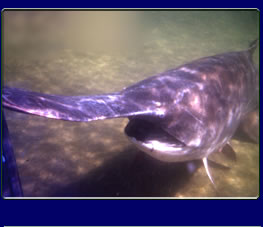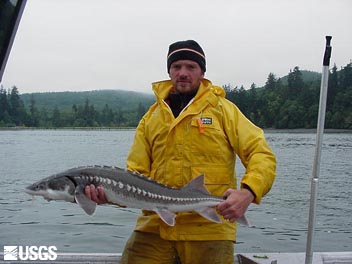- Home
- About S&T
- Taxa/Organisms
- Ecosystems
- Issues
- Methods & Tools
- Reports & Publications
- Location
- Search
Publisher: USGS | Science Center: Western Fisheries Research Center (WFRC, Seattle) | Format: URL
wfrc.usgs.gov — This research summary reports on the decline of Pacific lampreys (Lampetra tridentata) in the Columbia River Basin. Their numbers have declined to only a remnant of their pre-1940's populations. One factor that could be detrimental to lamprey production is the amount of energy they expend negotiating upstream fish passage facilities at dams. An More...

Publisher: USGS | Science Center: Western Fisheries Research Center (WFRC, Seattle) | Format: URL
wfrc.usgs.gov — The goal of this study is to determine egress routes and egress timing of juvenile salmon with respect to passive particle movement in the tailrace of John Day Dam using ultra-sonic fish tracking technology. The objectives are to evaluate egress routes and egress timing of juvenile spring chinook salmon with respect to paired releases of neutrally More...

Publisher: USGS | Science Center: Western Fisheries Research Center (WFRC, Seattle) | Format: URL
wfrc.usgs.gov — This is a research summary who's project objectives are to: 1) Coordinate watershed stakeholders in order to guide the implementation of watershed restoration actions that are consistent with stakeholder objectives, 2) Monitor physical habitat conditions and natural production of juvenile, smolt, and adult steelhead in the Wind River sub-basin, More...

Publisher: USGS | Science Center: Western Fisheries Research Center (WFRC, Seattle) | Format: URL
wfrc.usgs.gov — Various strategies have been developed or proposed to aid in reversing the declines of migratory salmonid populations in the Columbia and Snake River basins. Knowledge of the cumulative effects of passage through single or multiple dams is important in assessing the relative effectiveness of in-river migration of fish versus downriver More...

Publisher: USGS | Science Center: Western Fisheries Research Center (WFRC, Seattle) | Format: URL
wfrc.usgs.gov — Mercury contamination from historic gold mining operations is widespread in many rivers, lakes, and reservoirs on the western slopes of the Sierra Nevada. A multidisciplinary investigation by USGS is attempting to better understand mercury dynamics and to identify hot spots within Camp Far West Reservoir in order to determine if remediation More...

Publisher: USGS | Science Center: Western Fisheries Research Center (WFRC, Seattle) | Format: URL
wfrc.usgs.gov — Many diseases of trout and salmon persist in our cultured fish stocks today, despite improvements in fish culture practices and years of research on vaccines and chemotherapeutants. An excellent example is bacterial kidney disease (BKD), caused by the bacterium Renibacterium salmoninarum. Infections by R. salmoninarum are considered by many to be More...

Publisher: USGS | Science Center: Upper Midwest Environmental Sciences Center (UMESC, LaCrosse) | Format: URL
www.umesc.usgs.gov — Paddlefish (Polyodon spathula) have been lost from four states and Canada, and 11 of 22 states within the remaining species range now list the paddlefish as endangered, threatened, or a species of special concern. Restoration of paddlefish populations is a shared goal of many state and federal agencies. UMESC scientists, in collaboration with the More...

Publisher: USGS | Science Center: Western Fisheries Research Center (WFRC, Seattle) | Format: URL
wfrc.usgs.gov — Bull trout were listed by the U.S. Fish and Wildlife Service as a threatened species throughout the Columbia and Klamath river basins in 1998, and Oregon has listed the North Fork Malheur River population "Of Special Concern". Reasons for the decline of bull trout in the Malheur River likely include habitat degradation, habitat fragmentation, and More...

Publisher: USGS | Science Center: Western Fisheries Research Center (WFRC, Seattle) | Format: URL
wfrc.usgs.gov — This study will provide information to determine if dredging activities in the navigation channel of the lower Columbia River influence the behavior of sturgeon and if the disposal of dredged materials will affect available habitat for sturgeon. In performing this research, the USGS will improve existing methodologies for analyzing fish movements More...

Publisher: USGS | Science Center: Western Fisheries Research Center (WFRC, Seattle) | Format: URL
wfrc.usgs.gov — McNary Dam on the Columbia River is the first mainstream dam downstream of the Snake and Columbia river confluence. Subyearling fall chinook salmon emigrate past McNary Dam in the summer when water temperatures approach the upper incipient lethal maximum. This project uses an array of thermographs to monitor water temperatures in the forebay of More...

Publisher: USGS | Science Center: Western Fisheries Research Center (WFRC, Seattle) | Format: URL
wfrc.usgs.gov — The goal of this project is to provide vital information on the current status of cutthroat trout (Oncorhynchus clarkii) populations as a necessary prerequisite to determining need and type of future recovery efforts. Coastal cutthroat trout were petitioned for listing under the Endangered Species Act in 1997.

Publisher: USGS | Science Center: Western Fisheries Research Center (WFRC, Seattle) | Format: URL
wfrc.usgs.gov — The Santa Ana sucker (Catostomus santaanae), was recently identified by the U.S. Fish and Wildlife Service (FWS) as a species of special concern. This sucker is endemic to the Los Angeles, San Gabriel, and Santa Ana river drainages of southern California. The purpose of this study was to develop a better understanding of environmental factors More...
